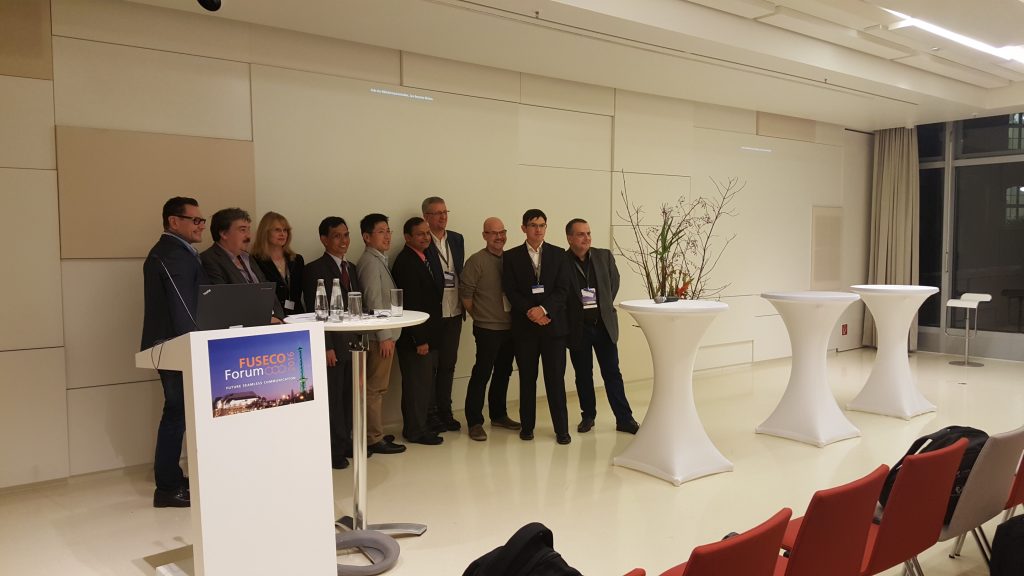The 7th Fokus FUSECO Forum, 2016, brought together international technology experts to present and debate about the latests developments. The Forum welcomed 32 nations in Berlin, Germany and split into two days of activities.
The first day consisted of Tutorials and Workshops about Access Technologies, Core and Service Platforms and Industrial Applications; and, the second day consisted of Conferences about Drivers for 5G.
Many are still wondering what 5G is, saying 5G is an evolution of the 4G or what operators will use in 2020. This is a question that ICCLab projects like MCN, T-NOVA and SESAME are contributing to. In brief, at the forum it was said that 5G is an end-to-end ecosystem that connects:
- Services we have today in a better way
- Things and people: sensors, cars, airplanes, etc.
- Markets that were not addressed before
Up until now, there have been changes in networking paradigms: networks can be programmed, network functions are implemented in software on top of common hardware, and NFV/SDN platforms act as end-to-end middleware between heterogeneous infrastructure for compute, storage and generic network function virtualisations (NFVs). This approach is essentially one taken up by NFV, inspired by cloud computing (primarily IaaS, in this case).
With this, use cases show up that require interoperability between a different set of devices with critical and low latency communications, require networks that have to be customised to satisfy the use cases’ needs and so challenges arise on how to integrate multiple network technologies and ensure compatibility across them. Moreover, 5G networks have to cover:
- Operator wide functionality
- QoS insurance
- Mobility Support with zero packet loss handover support
- Reliability for a massive number of IoT connections
Given that software networks depend on the infrastructure, one must not forget:
- Any component may fail at any moment
- Resources are unreliable with a higher delay
- Network characteristics are different
- Granularity of components varies
- In multi-domain, multi-service deployments there are many administrators
- Parallelism/Elasticity costs
- The network is heterogeneous
These aspects are considerations that we know well in considering the design of cloud native applications. Among other things, the forum talks mentioned the importance of new radio technology for IoT, called Narrow Bands NB-IoT, which would support non-IP data paths for short messages and the diversification of subscribers. Second, Identities in 5G was highlighted, where the complexity lies in a subscription manager for all types of devices. Third, key issues related to the NextGen Core Network (NGN), which is currently in a technical of high level requirements, have been identified. These include high session management, support for network slicing (multi-tenant virtual networks), charging, a security framework.
With orchestration engines for the slices infrastructure, the software network architecture offers new degrees of flexibility with:
- Network slices: flexible compute, storage and memory network containers.
- Flexible location: placed at the edge or centralized
- Flexible Backhaul: intermittent, large delay, etc.
Nevertheless, there is a wide variety of devices that connect to the network and have different policies. To solve the categorisation problem, given a deployed slice with function policies, Machine Learning (ML) is used to learn the infrastructure and can help differentiate policies and categorise these devices. This is much more engineering than what is used in the Telco world. Only issue is that for ML large enough training data is required, and for that the network needs to fail a lot. When it comes to the Network Topology topic, it can be created forcing a set of tunnels and router nodes or with service function chaining (SFC; netfloc). Experts on 5G expect massive M2M connections when the system goes to other markets and so if more SIM cards are to be sold there has to be:
- Dynamic Identity Management
- Dynamic connectivity policies
- Differentiated connectivity across locations
Moreover, 5G current main use cases include automotive and Industry. Industrial communications expect ultra low delay (both in-site backhaul and cross-site communication) and interference-tolerant radio technologies, with easy to configure and maintainable infrastructure. These conditions final purpose should be to deliver easy adaptation when changing the production floor environment and processes and avoid stagnation of the production line.
What we know for sure about 5G? First, there will be a new network generation up to 2020. Second, a joined, concentrated effort for standarisation across solution providers has to exist. Third, 5G will be software dominated (NFVs will support the infrastructure) and trials with companies are the way to go forward with current 5G business cases. Finally, whereas a new RAN will appear, LTE and WLAN are here to stay.
Stay tuned for updates on the second day of the FUSECO Forum!
